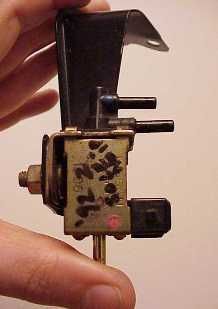
I did not originally recommend this as a routine procedure. My [Fuel] Pressure Regulator Vacuum Relief (PRVR) solenoid went bad which caused some starting issues. Took me forever to isolate the problem. My car would chug terribly for about a half a minute during a warm (not cold, not hot) start. Once I bypassed the solenoid, my car ran and started perfectly so I never bothered to replace it. That was back in 2003. So now I feel comfortable in recommending removal of the system if you're into simplifying the engine bay, and cleaning out extra vacuum lines as future potential sources of leaks, like me.
The PRVR solenoid is controlled by the ECU (the car's central computer) and only operates during a warm start in a specific temperature range for the first thirty seconds or so. The valve opens and introduces atmospheric pressure into the fuel rails from a canister that is stored in the drivers fender well. Contrary to popular belief, the system does NOT pump positive pressure into the fuel rails but simply "relieves" negative "pressure" or vacuum that could have developed from fuel cooling down in the fuel rails, hence the system's name.
The idea was that the PRVR system prevented vapor lock. Based on my hearsay research, I believe that the system was invented because of a problem that haunted Datsun engineers back in the early days of carbureted 240 Z's, namely vapor lock when the car was started warm. I think the Nissan engineers became paranoid after that and invented the PRVR system, although that is a total guess on my part.
 Remove the bolts holding the fuel filter bracket shown by the white arrows. The PRVR solenoid bracket underneath can then be lifted up and out of the car. Remove the bolts holding the fuel filter bracket shown by the white arrows. The PRVR solenoid bracket underneath can then be lifted up and out of the car.
Disconnect the electrical harness and pull or cut off the vacuum lines from the solenoid. The green arrows show vacuum lines that are part of the PRVR system that disappear into the driver's side fender well. They can simply be cut near the fender well. The electrical connector to the solenoid can be left dangling, and it will not throw any error codes at the ECU (electronic control unit).
 Here is the PRVR solenoid still attached to the bracket. The PRVR, AIV, and EGR solenoids are identical, they only differ in where they are found in the car and to which system they are connected. Here is the PRVR solenoid still attached to the bracket. The PRVR, AIV, and EGR solenoids are identical, they only differ in where they are found in the car and to which system they are connected.
 These are the connections at the engine from the PRVR system. Remove these vacuum lines and connect the two hard lines at the engine with a new piece of vacuum line. These are the connections at the engine from the PRVR system. Remove these vacuum lines and connect the two hard lines at the engine with a new piece of vacuum line.
 The orange hose is connecting the two hard points on the engine where the PRVR system was originally connected. The orange hose is connecting the two hard points on the engine where the PRVR system was originally connected.
The green arrow shows the hard line that leads to the fuel pressure regulator (FPR). Do NOT cap this line as the FPR needs to be connected to manifold pressure as shown in order to operate properly.
I've gotten E-mails from folks who said their PRVR hook-ups were different. The important point is to keep manifold pressure supplied to the FPR once you remove the PRVR solenoid and vacuum lines, otherwise a potentially dangerous lean engine condition could be created.
The PRVR canister is behind the driver's tire fender well. The now inoperational canister can be left in place, no harm, no foul. In order to remove the PRVR canister, the driver's side tire has to be removed, and the rear part of fender well peeled back to reveal this -
 Red X is PRVR canister in driver's side fender well. Green X is clutch vacuum assist tank. Red arrow where the AIV was disconnected and removed. Red X is PRVR canister in driver's side fender well. Green X is clutch vacuum assist tank. Red arrow where the AIV was disconnected and removed.
 PRVR canister in vitro. Just undo the two 10 mm bolts that go through the holes in the upper left corner, leave the bracket alone. PRVR canister in vitro. Just undo the two 10 mm bolts that go through the holes in the upper left corner, leave the bracket alone.
I have never heard of any 300ZX TT that suffered vapor lock with or without the PRVR in place. I deleted mine as a fix for a faulty PRVR solenoid as mentioned above. My car ran fine afterwards so I never bothered to replace it. Nor am I aware of anyone ever reporting a problem of any kind after deleting their PRVR. Not one. Consider it safe.
| 


